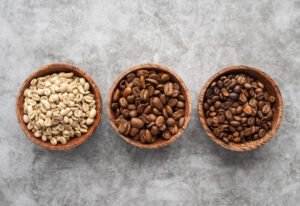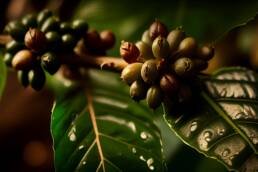Table of Contents
ToggleIntroduction
Hey there Coffee Lover.
Ever wondered about how coffee is made? And I don’t mean how to brew coffee, I mean how coffee is produced/grown/made. As a budding coffee enthusiast, I am curious about how coffee came to be and I imagine coffee lovers are too. I also imagine most coffee lovers know the process but some won’t and that’s where I come in. Coffee has a fascinating journey from seed to sip and in this post, I shall take you on a coffee journey. Understanding the process of coffee production will add a new layer of appreciation to the cup of joe that fuels your day.

A Brief History of Coffee
Many many years ago, a goat herder in Ethiopia called Kaldi, discovered his goats got hyperactive after eating red berries from a particular tree. He decided to try the berries himself and noticed he was invigorated and his senses heightened.
Intrigued by the effect of the berries, Kaldi shared his discovery with a local monastery. The monks discovered the berries kept them awake during long hours of prayer and meditation. They dried the berries and made it into a drink. This is the foundation for what we now know as coffee and our first insight into how coffee is made.
The legend of Kaldi, the goat herder who mistakenly stumbled upon coffee berries, remains the beginning of coffee’s story and later on coffee culture. It reminds us that sometimes extraordinary discoveries come from the most unassuming moments.

How Coffee Is Made – The Coffee Growing Process
Below are the steps on how coffee journeys from seed to your cup.
Planting the Coffee Seed
The journey of coffee starts with the planting of seeds. Coffee plants belong to two main species: Arabica and Robusta. Coffee cultivators carefully select the best seeds from ripe cherries. These seeds grow into little plants in a nursery. When the seeds are big enough, they are moved to the coffee farm where they can be spaced out. Farmers take care of them by watering them, protecting them from bugs, and giving them plant food. After a few years, the plants grow and make cherries that are ready to be picked. This is the first step in making coffee.
Nurturing the Coffee Plant
A crucial aspect of nurturing coffee plants is a keen focus on factors like water, sunlight, and nutrients- tailoring care to the specific needs of the plants. Regular monitoring helps with issues like pests or diseases while nurturing strong, mature plants over the years. The success of this stage is important as it influences the flavour and quality of the coffee beans harvested. This gives a glimpse into the dedication it takes for coffee farmers to create and maintain a good environment for the coffee seeds.

Blossoming and Harvesting
As the coffee plants mature, they produce white flowers which later transform into coffee cherries. This is the onset of harvesting season. As the cherries ripen, they turn from green to deep red. At this stage, skilled hands pick them carefully.
During harvest, only the ripe cherries are selected. This phase is labour-intensive and a very important phase in how to make coffee because it determines the quality and characteristics of the beans that will eventually find their way into your cup.

Roasting – Unveiling the Aromas
When coffee beans are harvested, they come out green. Roasting is what turns green coffee beans into the aromatic brown beans we know. The beans develop their taste and aroma during this roasting stage. Roasters must control the temperature and time to bring out distinctive flavours. The beans are either light, medium, or dark roast. Roasting the beans reveals unique qualities hidden within each bean.

Processing and Drying
This is the last stage in the process and it employs the wash and natural methods. The Washed method involves removing the outer skin, and then fermenting to eliminate any remaining mucilage. This method often results in a cleaner and brighter flavour. The Natural method is when the cherries are dried whole, allowing the beans to absorb sugars from the fruit. This can give a fruity flavour to the coffee.

Conclusion:
After roasting, the coffee beans are ready for the grand finale – the brew. You can now choose whatever type of brewing process you like and enjoy your cup of joe knowing that each step, from planting to roasting, contributes to the unique profile of the coffee in your cup.
I bet as you savour your next cup of coffee, you will have a slightly different experience knowing the process it took for the seed to travel to sip, not to mention coffee’s many benefits. From the historic hillsides of Ethiopia to the carefully tended fields of modern coffee farms, the story of coffee is one of cultivation, nurturing, and roasting – a story that continues to evolve with every sip.

esewalter
Mom | Yoga Teacher | Coffee Blogger | Legal Mind. I explore coffee's journey from farm to cup and especially how you can start your home brewing journey.




